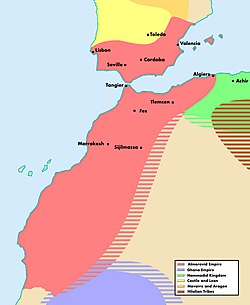അൽമൊറാവിദ് സാമ്രാജ്യം
മൊറോക്കോ കേന്ദ്രീകരിച്ച് പതിനൊന്നാം നൂറ്റാണ്ടിൽ രൂപപ്പെട്ട ഒരു ബെർബർ രാജവംശമായിരുന്നു അൽമൊറാവിദ് അഥവാ അൽ മുറാബിതൂൻ (അറബി: المرابطون)[2][3][4].
അൽമൊറാവിദ് സാമ്രാജ്യം المرابطون, അൽ മുറാബിതൂൻ | |||||||||||||||
|---|---|---|---|---|---|---|---|---|---|---|---|---|---|---|---|
| 1040–1147 | |||||||||||||||
|
Flag | |||||||||||||||
 അൽമൊറാവിദ് സാമ്രാജ്യം ഏറ്റവും വികസിതമായ സമയത്ത് (1120) | |||||||||||||||
| സ്ഥിതി | Ruling dynasty of Morocco | ||||||||||||||
| തലസ്ഥാനം | |||||||||||||||
| പൊതുവായ ഭാഷകൾ | Berber languages, Arabic, Mozarabic | ||||||||||||||
| മതം | ഇസ്ലാം (സുന്നി); ന്യൂനപക്ഷം ക്രിസ്ത്യാനികൾ (കത്തോലിക്കർ), ജൂതന്മാർ | ||||||||||||||
| ഭരണസമ്പ്രദായം | Hereditary monarchy | ||||||||||||||
| അമീർ | |||||||||||||||
• 1040–1059 | അബ്ദല്ലാഹ് ഇബ്ൻ യാസീൻ | ||||||||||||||
• 1146–1147 | ഇസ്ഹാഖ് ഇബ്ൻ അലി | ||||||||||||||
| ചരിത്രം | |||||||||||||||
• Established | 1040 | ||||||||||||||
• Disestablished | 1147 | ||||||||||||||
| 1120 est.[1] | 1,000,000 കി.m2 (390,000 ച മൈ) | ||||||||||||||
| നാണയവ്യവസ്ഥ | അൽമൊറാവിദ് ദിനാർ | ||||||||||||||
| |||||||||||||||
ചരിത്രം
തിരുത്തുകപടിഞ്ഞാറൻ ആഫ്രിക്കയിലും അൽ അന്തലൂസിലുമായി വ്യാപിച്ച ഈ സാമ്രാജ്യം, 1062-ൽ അബ്ദല്ലാഹ് ഇബ്ൻ യാസീൻ ആണ് സ്ഥാപിച്ചത്. മറാക്കിഷ് ആസ്ഥാനമായാണ് ഭരണം നടന്നിരുന്നത്. പടിഞ്ഞാറൻ സഹാറയിലെ നാടോടി ബെർബർ വംശത്തിൽ നിന്നാണ് രാജകുടുംബത്തിന്റെ ഉദ്ഭവം.[5][6]
ഐബീരിയയിലെ ക്രിസ്ത്യൻ രാജാക്കന്മാരോട് അൽ അന്തലൂസിന്റെ പതനം ഒരു സമയം വരെ പിടിച്ചുനിർത്തുന്നതിൽ അൽ മൊറാവിദ് ഭരണകൂടത്തിന്റെ പങ്കാളിത്തം ഇടയാക്കി. 1086-ൽ സഗ്റജാസ് യുദ്ധത്തിൽ കാസ്റ്റിൽ-ആരഗോൺ സംയുക്തസേനയെ ഇവർ പരാജയപ്പെടുത്തി. ഇതോടെ വടക്ക് നിന്ന് 3000 കിലോമീറ്റർ തെക്കോട്ട് പരന്നുകിടന്ന സാമ്രാജ്യത്തിന്റെ അധിപരായി അൽമൊറാവിദ് മാറി.
ഖലീഫ എന്ന സ്ഥാനം ഇവർ അവകാശപ്പെട്ടിരുന്നില്ല, പകരം അമീറുൽ മുസ്ലിമീൻ എന്ന പദവി സ്വീകരിച്ചുവന്നു. ബഗ്ദാദിലെ അബ്ബാസിയ ഖിലാഫത്തിന്റെ മേധാവിത്തം ഇവർ അംഗീകരിച്ചുവന്നു.[7]
അൽമൊറാവിദുകളുടെ ആധിപത്യം, പക്ഷെ അധികകാലം നീണ്ടുനിന്നില്ല. 1147 ഏപ്രിൽ മാസത്തിൽ അന്നത്തെ രാജാവായിരുന്ന ഇസ്ഹാഖ് ഇബ്ൻ അലി കൊല്ലപ്പെടുകയും, അൽമൊഹാദ് ഖിലാഫത്ത് ഭരണമേൽക്കുകയും ചെയ്തു.
ചിത്രശാല
തിരുത്തുക-
പതിനൊന്നാം നൂറ്റാണ്ടിലെ അൽമൊറാവിദ് നേതാവ് അബു ബക്കർ ബിൻ ഉമർ ("റെക്സ് ബുബേക്കർ") സെനഗൽ നദിക്കരയിൽ - ഒരു ചിത്രീകരണം
അവലംബം
തിരുത്തുക- ↑ Turchin, Peter; Adams, Jonathan M.; Hall, Thomas D. (December 2006). "East-West Orientation of Historical Empires". Journal of World-systems Research. 12: 222–223. ISSN 1076-156X. Retrieved 1 August 2020..
- ↑ Norris, H.T.; Chalmeta, P. (2012). "al-Murābiṭūn". In Bearman, P.; Bianquis, Th.; Bosworth, C.E.; van Donzel, E.; Heinrichs, W.P. (eds.). Encyclopaedia of Islam, Second Edition. Brill.
- ↑ Sadiqi, Fatima, The place of Berber in Morocco, International Journal of the Sociology of Language, 123.1 (2009): 7–22 : "The Almoravids were the first relatively recent Berber dynasty that ruled Morocco.
- ↑ G. Stewart, Is the Caliph a Pope?, in: The Muslim World, Volume 21, Issue 2, pages 185–196, April 1931: "The Almoravid dynasty, among the Berbers of North Africa, founded a considerable empire, Morocco being the result of their conquests"
- ↑ Extract from Encyclopedia Universalis on Almoravids.
- ↑ Extract from Encyclopedia Universalis on Almoravids.
- ↑ Kennedy, Hugh (2016-10-11). Caliphate: The History of an Idea (in ഇംഗ്ലീഷ്). Basic Books. ISBN 978-0-465-09438-7.
സ്രോതസുകൾ
തിരുത്തുക- Ibn Khaldun, Abderahman (1377). تاريخ ابن خلدون: ديوان المبتدأ و الخبر في تاريخ العرب و البربر و من عاصرهم من ذوي الشأن الأكبر [The history of Ibn Khaldun: Record of the Beginnings and Events in the History of the Arabs and Berbers and their Powerful Contemporaries]. Vol. 6. دار الفكر.
- Ibn Abi Zar al-Fassi, Ali Abu al-Hassan (1326). روض القرطاس في أخبار ملوك المغرب و تاريخ مدينة فاس [The Garden of Pages in the Chronicles of the Kings of Morocco and the History of the City of Fes]. Uppsala University.
- al-Bakri (1068). كتاب المسالك و الممالك [Book of the Roads and the Kingdoms]. دار الكتاب الإسلامي, القاهرة.
- Ibn Idhari al-Murakushi, Ahmad (1312). البيان المغرب في أخبار الأندلس والمغرب [Book of the Amazing Story in the Chronicles of the Kings of al-Andalus and Morocco]. جامعة الملك سعود.
- Brett, M. and E. Fentress (1996), The Berbers. Oxford: Blackwell.
- Hrbek, I. and J. Devisse (1988), "The Almoravids", in M. Elfasi, ed., General History of Africa, Africa from the Seventh to the Eleventh Century, UNESCO. 1992 edition, Ch. 13, pp. 336–66.
- Insoll, T (2003). The Archaeology of Islam in Sub-Saharan Africa. Cambridge: Cambridge University Press.
- Lewicki, T. (1988), "The Role of the Sahara and Saharians in relationships between north and south", in M. Elfasi, ed., General History of Africa, Africa from the Seventh to the Eleventh Century, UNESCO. 1992 edition, ch.11, p. 276–313.
- Levtzion, N. and J. F. P. Hopkins, eds (1981), Corpus of Early Arabic Sources for West African History, Cambridge, UK: Cambridge University Press. 2000 edition.
- Messier, R. A. (2010), Almoravids and the Meanings of Jihad, Santa Barbara, Calif.: Praeger.
- Mones, H. (1988), "The conquest of North Africa and Berber resistance", in M. Elfasi, ed., General History of Africa, Africa from the Seventh to the Eleventh Century, UNESCO. 1992 edition, Ch. 9, p. 224-46.
- Moraes Farias, P. F. de (1967), "The Almoravids: Some Questions Concerning the Character of the Movement", Bulletin de l’IFAN, series B, 29:3–4, pp. 794–878.
- This article incorporates text from a publication now in the public domain: Chisholm, Hugh, ed. (1911). "Almoravides". എൻസൈക്ലോപീഡിയ ബ്രിട്ടാനിക്ക. Vol. 1 (11th ed.). കേംബ്രിഡ്ജ് സർവകലാശാല പ്രസ്സ്. pp. 717–718.
{{cite encyclopedia}}: Invalid|ref=harv(help)
